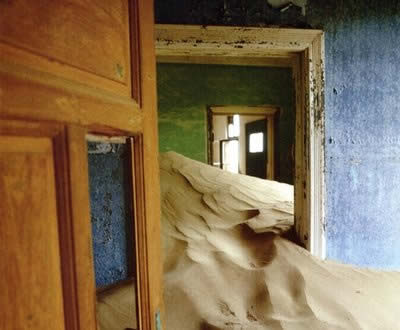I've been fascinated lately with a little corner of the world in southern Africa, the country of Namibia and its forbidden diamond-mining zone near the its southwestern, aka Skeleton, coast.
I first learned about this area from the film The King is Alive, which was filmed there (and a film which I recommend). I thought that the film The Bird Can't Fly was filmed there, too, but with a little research found it was filmed in the Atlantis Dunes about 25 miles north of Cape Town, South Africa. Unlike ...King..., The Bird Can't Fly (also recommended) was filmed on a rather brilliantly-constructed set of mainly the tops of buildings placed atop the sand, giving the illusion that the fierce desert sands had swallowed a whole town.King was filmed in an actual abandoned/ghost mining town where the desert sands are overtaking the decrepit structures, in some cases filling rooms of buildings to the ceiling with drifting sand. King is a dark film made under Dogme 95 rules/auspices; Bird is a tad lighter in spirit.
Another similar area in a significantly differently part o' the world (hell, another continent) is the Lencois Maranhenses of northeastern Brazil's coast. This is a unique desert that at certain times of the year has lakes. I learned about this area from a worthwhile film, again:The House of Sand (Casa de Areia). I suppose what all three films do so well is use the desert environment as a tangible character in the films' narratives (much like the Nostromo spaceship was such a character in Ridley Scott's Alien), while also being so stark and barren that the human characters really stand out more than they would in other contexts or settings.
On the documentary front, the excellent Arlit: Deuxieme Paris is desert-set (Sahara in Niger, Africa), and, again, there's a mining connection (uranium). As in the three fictional films previously mentioned, this documentary captures the ennui and existential angst that ghost towns and desert settings with small groups of people seems to bring out so succinctly. In the case of the Sperrgebiet (forbidden area) in Namibia, it's interesting that the colonizing country (Germany, Holland, whatever) tried to recreate the architecture and general way of life they were used to in Europe in the completely different ecology of a desert, often with haunting results.
There's also a cool ghost town scene in an abandoned or un-completed hotel in my friend Ryan Harper's film Circulation, which was filmed in Baja, Mexico.


No comments:
Post a Comment